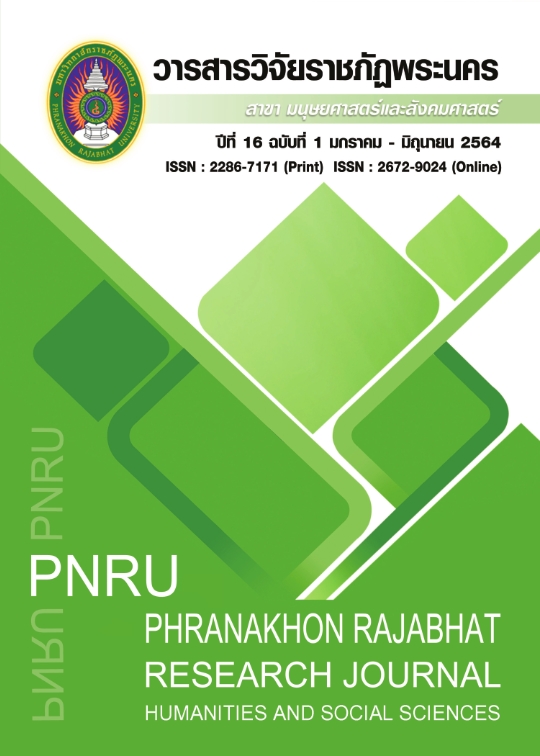THE COMPARISON OF FACTORS FOR CHOOSING A TOURISM DESTINATION: A CASE STUDY OF BANGKOK-BALI
Main Article Content
บทคัดย่อ
The objective of this research was to present a comparative study of factors affecting the tourists’ choosing a tourism destination between Bangkok and Bali. This study was a mixed methods research between a quantitative research and a qualitative research. A field study was conducted to collect data from foreign tourists traveling in Bangkok and using travel agency services. In addition, data were collected from tourists visiting various tourist destinations in Bali. From the said process, related factors and tourists’ satisfaction affecting selection for their travel destinations were investigated using Travel & Tourism Competitiveness Index (TTCI) to create research instrument with 11 elements (included Tourist attractions, Tourist infrastructure, Amenities, Atmosphere, Recreation areas, Public facilities, Accessibility, Social environment, Social hospitality, Politics and Economics, and Organization and Management) for data collection. The results could be summarized that factors affecting tourists’ satisfaction in choosing tourist destinations in Bangkok and Bali indicated that both groups had consistent opinions on good amenities for all types of tourists, Tourist infrastructure, traffic and availability of tourist information centers. However, they expressed their different opinions in some aspects such as attraction and impression due to different context of a destination.
Article Details
บทความที่ได้รับการตีพิมพ์เป็นลิขสิทธิ์ของมหาวิทยาลัยราชภัฏพระนคร
ข้อความที่ปรากฏในบทความแต่ละเรื่องในวารสารวิจัยราชภัฏพระนครเล่มนี้เป็นความคิดเห็นส่วนตัวของผู้เขียนแต่ละท่านไม่เกี่ยวข้องกับมหาวิทยาลัยราชภัฏพระนคร และคณาจารย์ท่านอื่นๆในมหาวิทยาลัยฯ แต่อย่างใด ความรับผิดชอบองค์ประกอบทั้งหมดของบทความแต่ละเรื่องเป็นของผู้เขียนแต่ละท่าน หากมีความผิดพลาดใดๆ ผู้เขียนแต่ละท่านจะรับผิดชอบบทความของตนเองแต่ผู้เดียว
เอกสารอ้างอิง
Alma, B. (2007). Manajemen Pemasaran dan Pemasaran Jasa. Bandung: Penerbit Alfabeta.
Anonim. (2008). Kamus Besar Bahasa Indonesia. Edisi Keempat. Jakarta: Gramedia Pustaka
Utama.
Ardika, I. W. (2003). Pariwisata Budaya Berkelanjutan: Refleksi dan Harapan di Tengah
Perkembangan Global. Denpasar: Universitas Udayana.
Bali: The Land of Spiritualism. (2010). From http://www.rtc.ac.th/www_km/03/033/033241153.pdf
Bangkok Sawadee.com. (2018). Bangkok Tourist Information. http://www.sawadee.co.th/bangkok/bangkok.html
Barsky, J. (2012). Points, Price, Promotions? How Guests Select Hotels Around the
World. From: http//hotelexecutive.com/business_review/3381/points-price-
promotions-how-guests-select-hotels- around-the-world (Accesed: 2016, March 29).
Budpar. (2010). From www.budpar.go.id. Perkembangan Desa Wisata di Indonesia.
Department of International Economic Affairs. (2012). World Economic Forum Framework
Agreement. Ministry of Foreign Affairs. From http://www.mfa.go.th/business/th/cooperation/252/16479-World-Economic-Forum-(WEF).html
Cooper, C. & Stephen, J. (1997). Destination Life Cycle: The Isle of Man Case
Study. Dalam the Earthscan Reader in Sustainable Tourism. United Kingdom: Earthscan
Publications Limited.
Cooper, C., Jhon, F., David, G. & Stephen, W. (1993). Tourism Principle and
Practice. London: Pitman Publishing.
Disparda Bali. (2017). Akomodasi di Provinsi Bali menurut Kabupaten/Kota 2016. Denpasar:
Dinas Pariwisata Provinsi Bali.
Disparda Bali. 2018. Statistik Daerah Provinsi Bali.
Doorley, J. & Helio, F. G. (2010). Reputation Management: The Key to Successful
Public Relations and Corporate Communication. New York: Routledge Taylor & Francis
Group.
E-TAT journalist. (2012). Project to study Thailand Destination Image of foreign tourists
Bangkok: Eureka Consulting Co., Ltd. From
https://etatjournal.files.wordpress.com/2012/07/thailand-destination-image.pdf
Frank, R. H. (2011). Microeconomics and Behaviour Eighth edition. Mc. Graw Hill
International Edition. From https://m.tempo.co/read/news/2017/09/15/058909414/begini-sejarah-letusan-gunung-agung di-bali
Inskeep, E. (1991). Tourism Planning “An Integrated and Sustainable Development
Approach”. New York: Van Nostrand Reinhold.
Inskeep, E. (1999). Tourism Planning Integrated and Sustainable Development Approach. New York: Van Nostrand Reinhold.
Kusmayadi dan, S. (2002). Metodelogi Penelitian di Bidang Kepariwisataan. Jakarta: PT.
Gramedia Pustaka Utama.
Kotler, P. & Kevin, L.K. (2009). Manajemen Pemasaran Edisi 13, Jilid 1 dan 2.
Jakarta: Penerbit Erlangga.
Lupiyoadi, R. & Hamdani, A. (2008). Manajemen Pemasaran Jasa. Jakarta:
Salemba Empat.
Marpaung, H. (2000). Pengetahuan Kepariwisataan. Bandung: Alfabeta.
Mathieson, A & Wall, G. (1982). Tourism: Economic, Physical and Social Impact. Pitman
Publishing, Oxford University Press.
McIntyre, G. (1993). Sustainable Tourism Development: Guide for Local Planners. Spain:
World Tourism Organization.
Middleton, V.T.C. (1998). Sustainable Tourism: A Marketing Perspective. Oxford:
Butterworth Heinemann.
Ngamsom, B. (2001). The impacts of a bundle of travel determinants on repeat visitation: An exploratory study of tourism in Thailand. PhD thesis. Oklahoma: Oklahoma State University.
Natori, N. (Ed). (2001). A Guide Book for Tourism Based Community Development.
Publisher APTE.
Office of the National Economic and Social Development Council. (2015). Documentation for the workshop project in collaboration with government agencies on “Government Information and National Competitiveness Ranking” On Wednesday, November 25, 2015 at Centra Government Center and Convention Center Bangkok. (In Thai)
Pitana, I Gde. (1999). Pelangi Pariwisata Bali. Denpasar: Bali Post.
Pitana, I Gde. (2006). Kepariwisataan Bali Dalam Wacana Otonomi Daerah. Jakarta: Puslitbang
Kepariwisataan.
Soekadijo, R.G. (1997). Anatomi Pariwisata (Memahami Pariwisata Sebagai Systemic
Linkage). Jakarta: Gramedia Pustaka Utama.
Sukhothai Thammathirat Open University, (2013). Study Field Trip. Office of Education Services.
Sukhothai Thammathirat Open University. (In Thai)
Suwantoro, G. (2001). Dasar – Dasar Pariwisata. Yogyakarta: Andi.
Suwena, I. K. & Gusti, N.W. (2010). Pengetahuan Dasar Ilmu Pariwisata.
Denpasar: Udayana University Press.
Thai Publica, (2018) .WEF points Thai competitiveness up two places from 40 to 38 - but in
many ways the score is below the regional average. (In Thai) from
https://thaipublica.org/2018/10/wef-17-10-2018/
Tjiptono, F. & Gregorius, C. (2011). Pemasatan Strategik Edisi 2. Yogyakarta:
Penerbit ANDI.
Wall, G. & Alister, M. (2006). Tourism: Change, Impacts and Opportunities.
Pearson Prentice Hall.
Wongchaikul, P. (2019). WEF announces "the country with the highest potential for tourism
competition" in the world. "Thailand" is ranked 31st. (In Thai) from https://forbesthailand.com/news/travel/wef-%E0%B8%9B%E0%B8%A3%E0%B8%B0%E0%B9%80%E0%B8%97%E0%B8%A8-%E0%B8%A8%E0%B8%B1%E0%B8%81%E0%B8%A2%E0%B8%A0%E0%B8%B2%E0%B8%9E%E0%B8%97%E0%B9%88%E0%B8%AD%E0%B8%87%E0%B9%80%E0%B8%97%E0%B8%B5%E0%B9%88.html


